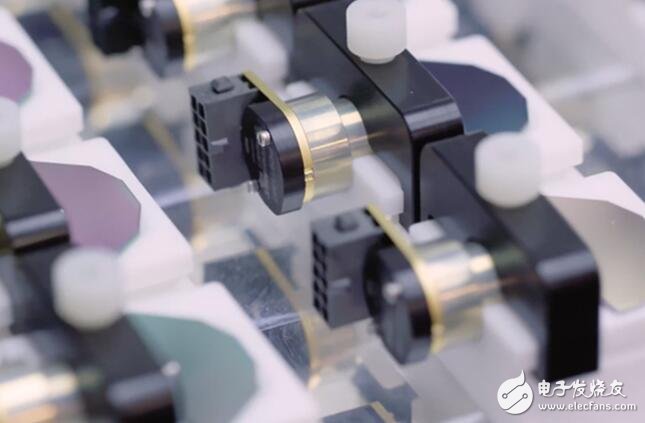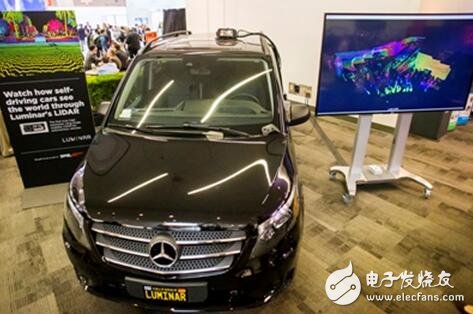According to Memes Consulting, Luminar Technologies, a start-up company for automotive LiDAR systems in the United States, is currently preparing for mass production of the new sensing platform and has begun to supply its four key strategic partners. Let's take a look at the related content with the car electronics editor. The venture-backed US company has been very low-key before, and it only gradually emerged after completing A-round $36 million in financing last year. Now the company's three branches have a total of 350 employees. The picture shows Luminar's next-generation LiDAR sensor receiver, which is said to have become the world's highest sensitivity and dynamic range of InGaAs receivers by matching ASICs developed by Luminar. Black Forest Engineering, a recently acquired chip designer from Luminar, is located in Colorado Springs, USA. Black Forest Engineering has been focused on high-performance InGaAs receivers for detecting 1550nm wavelength lasers unique to Luminar's LiDAR systems. According to Luminar, through its capacity expansion at its Orlando plant in Florida, by the end of the year, its capacity will reach 5,000 units per quarter, enough to assemble all of the current autopilot test vehicles worldwide. Luminar Chief Technology Officer Jason Eichenholz said at a company launch: "The main theme of our company last year was to validate the new LiDAR technology, and our main task in 2018 was to expand production." With the traffic accidents that caused deaths in Uber's autopilot test cars last month, autopilot technology was pushed to the cusp. Luminar stressed that they have been paying more attention to the performance of LiDAR sensors than to reducing system costs. . The picture shows Luminar's next-generation LiDAR sensor scanner with a highly manufacturable, customizable scanner that delivers unprecedented speed, reliability, and real-time configuration of scan modes. Luminar's 23-year-old founder and CEO, AusTIn Russell, said: "Environmental awareness is at the heart of autonomous driving. Therefore, for LiDAR sensors that are critical to human life, we still need to provide significant sensing performance." He believes that the need for better-performing hardware for autonomous vehicles is undisputed. The problem is: "The mass production of the new LiDAR sensor platform is faster." Luminar's acquisition of Black Forest Engineering will undoubtedly accelerate the company's mass production process. Black Forest Engineering has previously been involved in a number of Small Business Innovation Research (SBIR) programs designed to improve the performance of focal plane arrays (FPA). His most recent project was the second phase of the development of a small pixel pitch, large area array near-infrared FPA supported by the Missile Defense Agency. Stephen Gaalema, president of Black Forest Engineering, is a key researcher in the project. Luminar LiDAR sensor mounted on top of a Mercedes test car According to Luminar, the Black Forest Engineering team helped develop the InGaAs LiDAR receiver with the Luminar-designed ASIC to achieve record photon efficiency and dynamic range. "The combination with the Black Forest Engineering team has reduced the cost of our LiDAR receivers from tens of thousands of dollars in the past to just $3!" according to Luminar. Luminar's latest LiDAR sensor is only one-third the size, weight and power consumption of the previous version. In addition, thanks to the recent investment in capacity expansion, the assembly of this sensor takes only 8 minutes! However, this LiDAR sensor has no compromises in terms of performance. This is completely different from the competitors described by Luminar in the solid-state LiDAR field at the expense of performance in terms of size, weight, power consumption and cost. An important difference between Luminar and other LiDAR sensor suppliers is the use of 1550 nm wavelength lasers based on InP (Indium Phosphide) semiconductor wafer fabrication. At present, most automotive LiDARs use a lower-cost 905nm light source, and the laser can also be fabricated on a larger GaAs material. However, the longer wavelength of the Luminar laser has the human eye safety advantage, enabling it to adopt more Large power, achieving higher density point cloud data, thereby obtaining more perceptual information about the surrounding environment of the vehicle. In addition, another important advantage is the perception of low-reflecting objects, such as black cars, Luminar's LiDAR sensor can detect black cars at greater distances, which means that auto-driving cars at high speeds can get more time. Slow down in advance to avoid danger. With a single-chip, multi-channel 1550nm laser source, Luminar is said to deliver 40 times more power and 50 times more resolution than competing LiDAR on the market, enabling an effective level of detection over an order of magnitude of more than 200m. The American Institute of TOYOTA, one of Luminar's key partners, said that Luminar's technology has been evaluated since last year. Luminar also demonstrated a Mercedes-Benz off-road vehicle equipped with its LiDAR sensor at SPIE Photonics West in January 2018. Luminar acquired 30 engineers in addition to recruiting former Motorola executive Jason Wojack as vice president of hardware design. Wojack was previously responsible for product development for the famous Motorola RAZR series of mobile phones and MOTO 360 smart watches. Silicon Controlled Rectifier (SCR)
Silicon Controlled Rectifier (SCR) is short for silicon controlled rectifier. SCRs are available in one-way, two-way, turn-off, and light control types. It has the advantages of small size, light weight, high efficiency, long life, easy control, etc. It is widely used in occasions such as controllable rectification, voltage regulation, inverter, and non-contact switches and other automatic control and high-power electric energy conversion.
Silicon Controlled Rectifier,Scr Silicon Controlled Rectifier,3 Phase Silicon Controlled Rectifier,Semiconductor Silicon Controlled Rectifier YANGZHOU POSITIONING TECH CO., LTD. , https://www.cndingweitech.com

